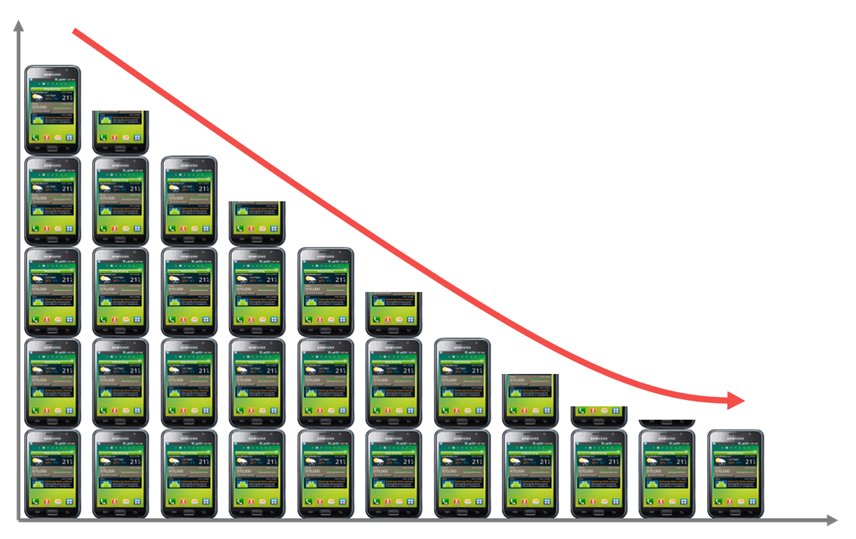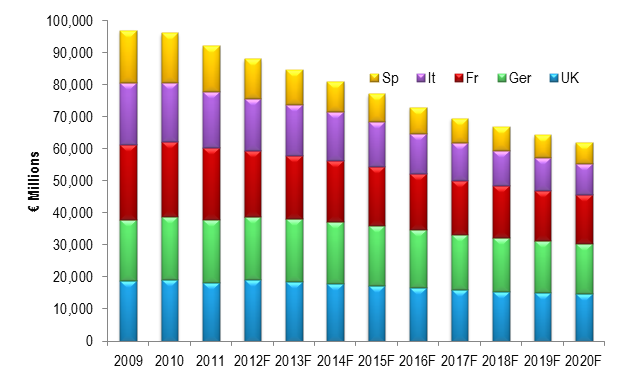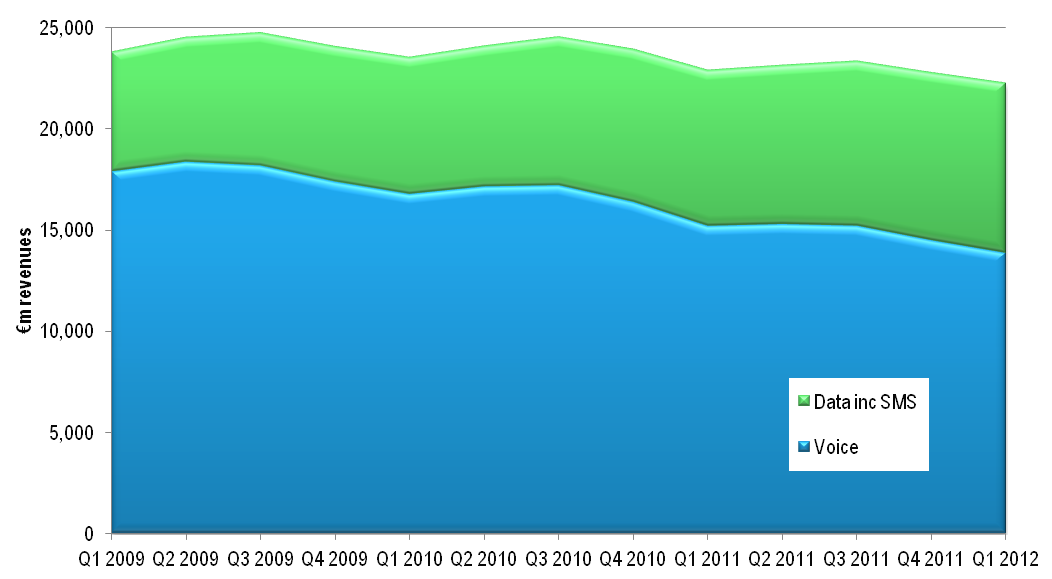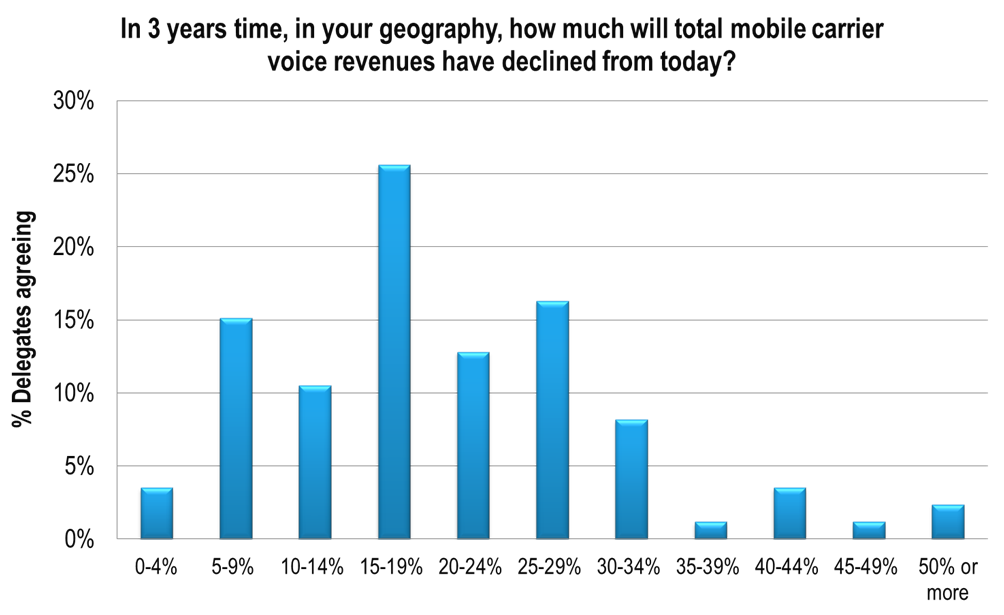
Below is an extract from this 48 page Telco 2.0 Report that can be downloaded in full in PDF format by members of the Telco 2.0 Executive Briefing service here. Non-members can subscribe here or other enquiries, please email / call +44 (0) 207 247 5003.
We'll also be discussing our findings at the New Digital Economics Brainstorms in Dubai (6-7 November, 2012) and Singapore (3-5 December, 2012).
To share this article easily, please click:
The mobile telecoms sector has performed quite strongly through the economic downturn but STL Partners’ forecast for UK, France, Germany, Spain and Italy suggests that the outlook is extremely bleak:

Source: European regulators, Mobile operators, Barclays Capital, STL Partners assumptions and analysis
We are starting to see a few European operators invest more actively in building new revenue streams – something that STL Partners has been pushing through its Telco 2.0 initiative for several years. Telefonica with Telefonica Digital, KPN, Orange, Telenor and a handful of other companies are becoming more active in ‘digital services’ and new business models. This activity urgently needs to be accelerated and prioritised if operators stand any chance of replacing the impeding revenue declines.
For future success, operators must embrace Telco 2.0 (and recognise the need for a new business model and new service offerings) whether that is as a lean ‘Telco 2.0 Happy Pipe’ or as a ‘Telco 2.0 Services Provider’. Both of these strategies require business model transformation that encompasses:
At the moment, the global telecoms industry seems to be in relatively robust health – developing economies are driving subscriber growth, 4G is being rolled out, smartphones are being connected with data plans in huge numbers, service providers are selling bundled “integrated offers” to maintain revenues, and costs are being controlled with network-sharing and other strategies
But there is also a nagging concern held by industry managers and observers that all is not well ‘below the waterline’, especially in mature markets. There have been a few worrying signs from operators losing out on messaging revenues to OTT players like WhatsApp, or suffering outright reductions in revenues and subscriber numbers in markets like Spain. That said, these have been largely ascribed to poor pricing decisions or (hopefully) temporary local macroeconomic problems.
Certainly, the financial markets seem pretty convinced in the operators’ underlying ability to turn consumers’ desire for communication into ARPU. Not only that, but there is broad conviction that growing data revenues should be able to offset – plus or minus a little – slow declines in voice and messaging, especially when it is all wrapped up in a bundle.
The question is whether that assumption is really valid, or whether there are broader structural risks, or even any reality in the dystopian view that revenues could suddenly ‘fall off a cliff’? Looking at the fixed telecom industry, it is notable that voice revenues have undergone a fairly precipitous decline over the past decade, partly because of mobile substitution, partly because of competition and, in some cases such as lucrative international calls, because of competition from Skype and its peers. Meanwhile, adjacent markets such as cable have started to suffer from the popularity of alternative sources of digital TV and content. Some of the fixed operators have picked up the slack with IT services and cloud infrastructure, but others have suffered – often to the extent that they have sold out, typically to their mobile peers.
Will mobile operators fare any better over the next 5-10 years? In developed markets, they have to contend with market saturation, increasing competition on basic services, and tightening regulatory regimes. They also need to deal with the strategic issue of the internet-based app ecosystems such as Apple’s and Google’s, and OTT-type services from the likes of Facebook and Microsoft/Skype. There is also a possibility that the very nature of ‘core services’ like telephony might change, as voice communications starts to get embedded into apps and the web itself. Some observers even see our 100-year relationship with voice telephony diminishing in importance, as other forms of communication become more useful.
This report looks into the mobile marketplace – specifically, voice and messaging services in the main European countries. We have constructed a “what if?” scenario model, that takes some basic assumptions about voice usage and pricing, along with data revenues trends. Rather than just assuming that ARPU will remain broadly flat and then divide it up between voice and data, we’ve started looking from the bottom up. Can likely declines in voice revenues really be made up elsewhere, especially given the possible collapse of SMS and the commoditisation of mobile data? Just how big might the gap be that needs to be filled with ‘other services’ such as content resale, two-sided capability exposure, M2M, vertical industries or Telco-OTT propositions?
Taking together the five largest European mobile markets – Germany, France, UK, Italy and Spain – paints a picture that should cause some alarm. Despite the rise of smartphones and dongles, overall quarterly mobile revenues are down 10% on their peak from Q3 2009; falling from €24.7bn to €22.2bn in Q1 2012. Even accounting for seasonality, this is significant (a €10bn annualised shortfall) – and early results suggest the fall accelerated in Q2 2012, as economic and competitive factors bit deeper into sales, with recessions in several countries and new entrants such as Free in France.
Worse, if we just look at voice revenues, the market is now down 25% from its peak in Q2 2009, and that fall seems to be accelerating. While declining voice ARPU is not a huge surprise, the failure of other services to take up the slack is disappointing, especially as the source of new business – basic data connectivity – also is the most capex-hungry in terms of extra costs of new spectrum and 3G/4G build-out.

To the best of our knowledge, nobody else has made forecasts that are both dispassionate and founded on hard data and bottom-up analysis.
Too many analyst (and we suspect internal) financial models seem to suggest that ‘It’ll be alright, somehow… telecoms operators need to harvest cash from voice and messaging, grow data and find some new revenues, but there’s plenty of options’. STL Partners is questioning the first and second premises in the statement above – about harvesting voice and messaging and growing broadband data – not because we’re pessimists, but because we think that many in the industry are not acknowledging the scale of the problems ahead and making the necessary (and often uncomfortable) decisions early enough.
It is fair to say that the fixed telecoms industry has undergone enough pain over the last decade to be under no illusions about its challenges. Operators realise that they face a continued hard slog against competition, regulation, content providers and indifferent consumers. They have increasingly focused on businesses, wholesale models and specific high-value niches like fibre-based triple-play. Deployment of FTTC/FTTH has been patchy, as they have realised that political support doesn’t equate to revenue uplift or return on capital.
Conversely, the mobile industry has pinned its hopes on LTE, data services and various collaboration and partnership business models. Some operators have essentially become Apple and Samsung resellers, offering credit-finance for expensive devices in the guise of handset subsidies. Plenty of other ideas, from mobile money to M2M to API exposure have been the subject of huge efforts. As yet, none has really moved the needle compared to the legacy telephony and SMS services that still make up a large (60%+) share of most operators’ top line revenues. The only bright spot has been plain-vanilla Internet access, initially with 3G dongle modems for PCs, and more recently for smartphone data plans. But the former has now gone largely ex-growth (thankfully, in some cases, given the traffic loads generated at low prices). And the latter faces growth challenges once most users have shifted to a smart device, as few users seem incentivised to upgrade to larger data plans so far.
In private discussions with operator executives, we encounter a fair level of pessimism, especially about voice and SMS revenues. At our conferences, we have asked senior executives (using our anonymised voting system) about possible price and value erosion, and are often surprised by how far and fast telcos seem to think these core services will dwindle.

We’ve seen investment banks’ forecasts that assume that ARPUs can be (mostly) maintained through the magic of bundling, while some operators themselves paint a picture that can, charitably, be seen as rose-tinted at best:

To read the note in full, including the following additional analysis...
...and the following figures...
...Members of the Telco 2.0 Executive Briefing Subscription Service can download the full 48 page report in PDF format here. Non-Members, please subscribe here or email / call +44 (0) 207 247 5003.
Technologies and industry terms referenced: strategy, voice, messaging, business model, UK, France, Germany, Italy, Spain, Europe, forecasts.